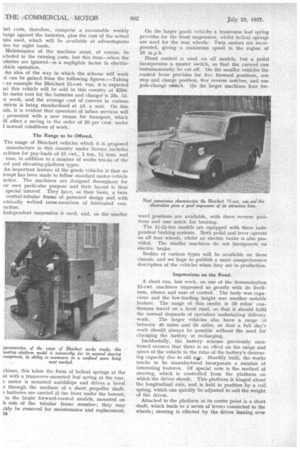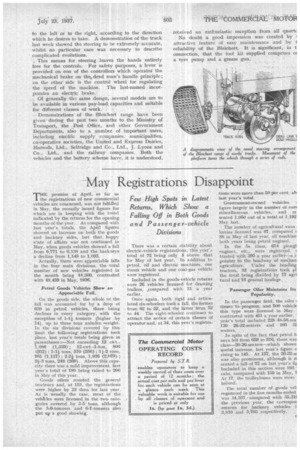BIG TRANSF RT EXPANSION SCHEME
Page 46

Page 47

Page 48

Page 49

If you've noticed an error in this article please click here to report it so we can fix it.
Marks Int
duction of Bleichert Range
The Production in This Country of Bleichert Electric Goods Vehicles to be Accompanied by an Important Scheme of Development. Treating the Batteries as "Fuel," the Machines are to be Sold at Competitive Prices
WIfILST this, country leads in one • field of electric traction for road vehicles, namely in the development of the trolleybus, any really big increase, in the use of batteryeelectric gooda vehicles has been retarded, clue -largely to their high first cost ;aid • the recurrent liability of . battery renewals.
• Despite these factors, however, the electric vehicle has, in the past two years, made considerable progress in various spheres of activity. For short-distance delivery work and municipal operation, the battery electric has a number of important advantages, and it is only on the score of capital charges that this type of transport unit has, perhaps, failed to make the progress it deserves.
From the national point of view, the use of homeproduced fuel is of important moment and only last week this question was debated in Parliament. It is obvious that, in the event of a national emergency, the country's stock of petrol and oil fuel will be available only in limited quantities to commercial users. A scheme whereby a big proportion of essential civil services can be maintained on home-produced fuel thus deserves close scrutiny on this score alone. When it brings in its train other advantages it is increasingly interesting.
Points in favour of the battery-electric vehicle include its silence, cleanliness, ease of control, and good acceleration. Moreover from the viewpoint of fuel cost, it is outstandingly economic. Maintenance costs are low and the vehicle has a long life. Its disadvantages lie in the cost of the batteries and the maintenance charges incurred.
After prolonged investigations of the problems associated with the development of the battery-electric 'vehicle, Mr. E. Cecil Kny, consulting engineer, of 19-21, Palace Street, London, S.W.1, has evolved a scheme which includes, not only the production of the Bleichert range of vehicles in this country on a large scale, but also an ingenious rental plan for the batteries, which ensures that there shall be no capital cost to the operator on this score; this make of vehicle is widely used in Germany.
a32 Furthermore, maintenance and replacements of the batteries will not cost the operator a penny. Production is to commence in the near future and the plans are now almost complete for the full scheme to be put into operation.
In an exclusive interview with Mr. Kny, our representative had outlined to him the details of the rental scheme. The British-made Bleichert vehicles are to be sold at a price competitive with all other forms of transport unit of the same carrying capacity. The batteries are treated as fuel" and the operator will pay only a fixed rental for these' at a reasonable rate, plus the actual number of units used.
• The payment of the weekly sum includes the free installation of a charging plant in the operator's own premises. It also provides for the maintenance of the batteries, which will be changed at regular intervals at the local service depot. Incidentally, the batteries can be replaced in approximately three minutes, so that the machine need not be put out of commission for this operation.
Standard battery units will be used throughout the
whole range of Bleichert machines, so that, whate type is purchased, the batteries will be the same. 'I policy, therefore, provides that the battery and char remain the property of the vehicle maker, but they I be supplied to the operator through the electric po,
company in his district. Obviously, this sac requires the co-operation of the power companies, their assistance has already been assured in many art What, then, does the operator gain by this scher In the first place, he can obtain, at a highly comp tive price, a first-class electric vehicle to suit his net Secondly, throughout its life he has no responsihi for the maintenance and replacement of the batter 'uel costs, therefore, comprise a reasonable weekly fiarge against the batteries, plus the cost of the actual nits used, which will be available at advantageous des for night loads.
Maintenance of the machine must, of course, be [eluded in the running costs, but this item—when the atteries are ignored—is a negligible factor in electricehicle operation.
An idea of the way in which the scheme will work at can be gained from the following figures :—Taking ; an example the Bleichert 15-cwt. van, it is expected ;at this vehicle will be sold in this country at £200. he Meter rent for the batteries and charger is 23s. 5d. ar week, and the average cost of current in various stricts is being standardized at Ad. a unit. On this Isis, it is evident that operators of urban services will presented with a new means for transport, which ill effect a saving in the order of 20 per cent. under 1 normal conditions of work.
The Range to be Offered.
The range of Bleichert vehicles which it is proposed manufacture in this country under licence includes achines for pay-loads of 15 cwt., 1 ton, 1! tons, and • tons, in addition to a number of works trucks of the ced and elevating-platform. types.
An important feature of the goods vehicles is that no tempt has been made to follow standard motor-vehicle actice. The machines are designed throughout for eir own particular purpose and their layout is thus special interest. They have, as their basis, a twin central-tubular frame of patented design and with ectrically welded cross-members of fabricated conuction.
Independent suspension is used, and, on the smaller chines, this takes the form of helical springs at the nt with a transverse-mounted leaf spring at the rear. e motor is mounted amidships and drives a bevel e through the medium of a short propeller shaft. e batteries are carried at the front under the bonnet, in the larger forward-control models, mounted on la side of the tubular frame member; they may ckly be removed for maintenance and replacement. 34 On the larger goods vehicles a transverse leaf spring provides for the front suspension, whilst helical springs are used for the rear wheels.Twin motors are incorporated, giving a maximum speed in the region of 18 m.p.h.
Hand control is used on all models, but a pedal incorporates a master switch, so that the current can instantaneously be cut off. On the smaller vehicles the control lever provides for five forward positions, one stop and charge position, five reverse notches, and one pole-change switch. On the larger machines four for ward positions are available, with three reverse positions and one notch for braking.
The 1i-2i-ton models are equipped with three independent braking systems. Both pedal and lever operate on all four wheels, whilst an electric brake is also provided. The smaller machines do not incorporate an electric brake.
Bodies of various types will be available on these chassis, and we hope to publish a more comprehensive description of the vehicles when they are in production.
Impressions on the Road.
A short run, last week, on one of the demonstration 15-cwt. machines impressed us greatly with its liveliness, silence and ease of control. The body was capacious and the low-loading height was another notable feature. The range of this model is 50 miles' continuous travel on a level road, so that it should fulfil the normal demands of operators undertaking delivery work. The larger vehicles also have a range of between 40 miles and 50 miles, so that a full day's work should always be possible without the need for changing the battery or recharging.
Incidentally, the battery scheme previously mentioned ensures that there is no effect on the range and speed of the vehicle in the ratio of the battery's decreasing capacity due to old age. Sturdily built, the works trucks to be manufactured incorporate a number , of interesting features. Of special note is the method of steering, which is controlled from the platform on which the driver stands. This-platform is hinged about the longitudinal axis, and is held in position by a coil spring, which can quickly be adjusted to suit the weight. of the driver.
Attached to the platform at its centre point is a short shaft, which leads to a' seriesof levers connected to the wheels; steering is effected by the driver leaning over to the left or to the right, according to the direction which he desires to take. A demonstration of the truck last week showed the steering to be extremely•accurate, whilst no particular care was necessary to describe complicated evolutions.
, This means for steering . leaves the hands entirely free for the controls. For safety purposes, a lever is provided on one of the controllers which operates the mechanical brake on the, dead man's handle principle ; on the other side is the control wheel for regulating the speed of the machine. The last-named incorporates an electric brake.
Of generally the same design, . several models are to be available in various pay-load capacities and suitable for different classes of work.
Demonstrations of the Bleichert range have been given during the past two months to the Ministry of Transport, the Post Office, and other Government Departments, also to a number of important users, including electric supply companies. municipalities, co-operative societies, the United and Express Dairies, Harrods, Ltd., Selfridge and Co., Ltd., J. Lyons and Co., Ltd., and the railway companies. Both the vehicles and the battery scheme have, it is understood, received an enthusiastic reception from all (parte
No doubt a good impression was created by I attractive feature of easy maintenance and by t reliability of the Bleichert. It is significant, in t connection, that the tool kit supplied comprises oi a tyre pump and a grease gun.




























































































